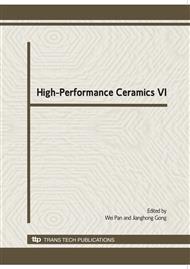p.369
p.371
p.376
p.382
p.386
p.389
p.393
p.397
p.400
Origin of Leakage Currents in ZnO Based Varistor Ceramics with Al(NO3)3 Dopant
Abstract:
The additive of Al(NO3)3 has been doped into ZnO varistors in order to reduce their residual voltages. However, the leakage currents of samples always increase at the same time. Generally, it is recognized that some of doped Al3+ ions enter the ZnO grains and reduce their resistivity, which results in lower residual voltages of varistor samples. On the other hand, the remnant Al3+ ions appear in the grain boundaries and also reduce their resistivity, which results in larger leakage currents. In this paper, the electrical properties of ZnO varistor samples with various amounts of Al(NO3)3 dopant were measured. The experimental data are compared with the numerical simulation results, which reveals that the increased leakage currents of ZnO varistors with Al(NO3)3 dopant are not only due to the decreased resistivity of grain boundaries, but also the increased donor density of ZnO grains.
Info:
Periodical:
Pages:
386-388
Citation:
Online since:
March 2010
Authors:
Keywords:
Price:
Сopyright:
© 2010 Trans Tech Publications Ltd. All Rights Reserved
Share:
Citation:


